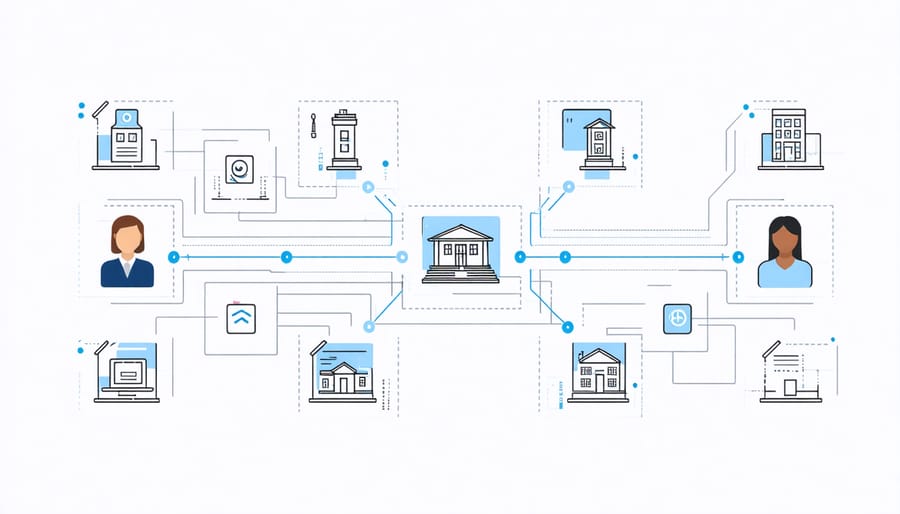Blockchain technology is revolutionizing how property developers and asset managers track, validate, and monetize their portfolios. By creating immutable digital records of ownership, maintenance history, and financial transactions, blockchain enables professionals to maximize property value through asset management with unprecedented efficiency and transparency.
Industry leaders implementing blockchain solutions have reported up to 30% reduction in administrative costs and 50% faster transaction processing times. From automated smart contracts that streamline property transfers to decentralized maintenance records that enhance accountability, blockchain’s distributed ledger technology is eliminating traditional pain points in asset management workflows.
Major institutions like JLL and CBRE have already deployed blockchain platforms to tokenize real estate assets, enabling fractional ownership and improved liquidity in previously illiquid markets. This technological shift represents more than just operational improvement—it’s fundamentally transforming how assets are owned, managed, and traded in the digital age.
For construction and property management professionals seeking to maintain competitive advantage, understanding and implementing blockchain solutions is no longer optional—it’s imperative for future-proofing asset management operations in an increasingly digitized industry.
Smart Contracts Transform Property Asset Management
Automated Contract Execution
Smart contracts on blockchain networks are revolutionizing how property management agreements are executed and monitored. Unlike traditional property management software solutions, blockchain-based smart contracts automatically execute predefined actions when specific conditions are met, eliminating the need for manual intervention and reducing administrative overhead.
These self-executing contracts handle various aspects of property management, including lease agreements, maintenance schedules, and payment processing. When a tenant submits rent payment, the smart contract automatically verifies the transaction, updates payment records, and distributes funds to relevant parties. Similarly, maintenance requests trigger automated workflows that notify service providers, schedule repairs, and process payments upon completion.
The implementation of smart contracts significantly reduces disputes by maintaining an immutable record of all transactions and agreement terms. For example, leading property management firm RedBrick Properties reported a 40% reduction in payment-related disputes after implementing blockchain-based contract automation.
Smart contracts also enable conditional executions based on real-time data from IoT devices. When sensors detect maintenance issues, contracts can automatically initiate repair protocols and adjust service schedules. This proactive approach to property management ensures timely maintenance while optimizing operational costs.
Furthermore, these automated systems provide unprecedented transparency, allowing all stakeholders to monitor contract execution in real-time, ensuring compliance with agreed-upon terms and conditions.

Real-time Asset Tracking
Real-time asset tracking through blockchain technology is revolutionizing how construction companies monitor and manage their resources. By implementing distributed ledger systems, organizations can now track construction materials and equipment from procurement to deployment with unprecedented accuracy and transparency.
The system works by assigning unique digital identifiers to physical assets, which are then recorded on the blockchain. Each movement, transfer, or status change is automatically logged as a new transaction, creating an immutable record that all authorized stakeholders can access. This eliminates the traditional challenges of manual tracking systems, such as data discrepancies, delayed updates, and human error.
Major construction firms implementing blockchain-based asset tracking have reported significant improvements in operational efficiency. For instance, a leading European construction company reduced equipment downtime by 32% after implementing blockchain tracking for their heavy machinery fleet. The system provides real-time visibility of equipment location, maintenance status, and utilization rates.
Key benefits include:
– Automated chain of custody documentation
– Instant verification of asset location and status
– Reduced theft and unauthorized usage
– Enhanced maintenance scheduling
– Improved inventory management
– Better compliance documentation
For construction materials, blockchain tracking enables verification of origin, quality certifications, and handling conditions throughout the supply chain. This is particularly valuable for critical materials requiring specific storage conditions or those with strict quality control requirements.
Implementation typically requires integration with IoT sensors and GPS tracking devices, creating a comprehensive digital ecosystem that provides accurate, real-time data while maintaining the security and immutability of blockchain technology.
Enhanced Security and Transparency

Immutable Record-Keeping
One of blockchain’s most significant contributions to asset management is its ability to create an immutable record-keeping system. Unlike traditional databases, blockchain technology ensures that once data is recorded, it cannot be altered or deleted without leaving a clear audit trail. This feature is particularly crucial for construction and property management firms dealing with complex asset portfolios and growing concerns about cybersecurity in property assets.
Each transaction or modification in an asset’s lifecycle is recorded as a new block, creating a chronological chain of events that can be traced back to the asset’s origin. This transparency enables stakeholders to verify the authenticity of asset-related information, from ownership transfers to maintenance records, with absolute certainty.
For construction firms managing multiple assets across different locations, blockchain’s distributed ledger technology provides a single source of truth. Every participant in the network maintains an identical copy of the record, eliminating discrepancies that often arise from multiple record-keeping systems. This feature has proven particularly valuable in managing equipment warranties, maintenance schedules, and regulatory compliance documentation.
The system’s cryptographic security ensures that records cannot be tampered with, reducing the risk of fraud and disputes. Additionally, smart contracts can automatically trigger and record asset-related actions, such as maintenance alerts or warranty claims, further enhancing the reliability of the record-keeping process.
Stakeholder Visibility
Blockchain technology revolutionizes stakeholder visibility in asset management by creating an unprecedented level of transparency and accountability throughout the project lifecycle. Every transaction, update, and modification to asset records becomes instantly visible to authorized stakeholders, eliminating information silos and reducing disputes.
In traditional asset management systems, stakeholders often struggle with delayed updates, inconsistent information, and limited access to critical data. Blockchain addresses these challenges by maintaining a distributed ledger that provides real-time visibility into asset status, maintenance records, and ownership transfers. This enhanced transparency enables project managers, investors, and facility operators to make more informed decisions based on accurate, up-to-date information.
The implementation of smart contracts further strengthens stakeholder relationships by automating compliance monitoring and contract execution. When predefined conditions are met, such as maintenance milestones or regulatory requirements, the system automatically triggers notifications and updates to all relevant parties. This automation reduces the risk of miscommunication and ensures all stakeholders remain aligned with project objectives.
Case studies from leading construction firms demonstrate that blockchain-enabled transparency can reduce dispute resolution time by up to 75% and improve stakeholder satisfaction rates by 40%. The technology’s immutable nature ensures that all historical data remains accessible and tamper-proof, providing a reliable audit trail for regulatory compliance and dispute resolution.
For effective implementation, organizations should establish clear protocols for data access and permission levels while maintaining the delicate balance between transparency and confidentiality. This approach ensures that stakeholders receive relevant information without compromising sensitive business data.
Implementation Case Studies
Commercial Property Development
A pioneering implementation of blockchain technology in commercial property development comes from Harbor Square, a $50 million mixed-use development project in Singapore. This case study demonstrates how blockchain revolutionizes traditional property development processes while ensuring unprecedented transparency and efficiency in asset management.
The project utilized a permissioned blockchain network to digitize and manage construction documentation, property titles, and stakeholder agreements. By implementing smart contracts, the development team automated various processes, including contractor payments, material procurement, and regulatory compliance verification. This resulted in a 40% reduction in administrative overhead and a 60% decrease in document processing time.
Key benefits observed in the Harbor Square implementation included:
1. Real-time tracking of construction progress and materials
2. Automated compliance verification with building codes
3. Transparent stakeholder communication
4. Immutable record-keeping for warranties and maintenance
5. Streamlined tenant management post-construction
The technology’s impact extended beyond the construction phase. Post-completion, the blockchain platform facilitated efficient property management by maintaining a comprehensive digital twin of the building. This enabled automated lease agreements, simplified maintenance scheduling, and real-time monitoring of building systems.
The project’s success has led to widespread adoption across the commercial property sector. Industry leaders report that blockchain implementation typically results in:
– 25-30% reduction in project delays
– 15-20% decrease in dispute-related costs
– 35% improvement in stakeholder collaboration
– Enhanced security in property transactions
For construction professionals considering blockchain adoption, the Harbor Square case demonstrates the importance of early stakeholder engagement and comprehensive system integration. The project team emphasized the need for proper training and change management strategies to ensure successful implementation.
The experience gained from this implementation has established a blueprint for future commercial property developments, highlighting blockchain’s potential to transform traditional construction and asset management practices.

Infrastructure Asset Management
Infrastructure asset management has emerged as a prime beneficiary of blockchain technology, particularly in large-scale construction and development projects. The distributed ledger system offers unprecedented transparency and traceability in tracking physical assets throughout their lifecycle, from procurement to maintenance and eventual decommissioning.
A notable example is the Sydney Harbour Bridge maintenance project, where blockchain implementation has revolutionized asset tracking and maintenance scheduling. The system maintains an immutable record of all inspections, repairs, and component replacements, ensuring accurate historical data and predictive maintenance capabilities. This implementation has reduced maintenance costs by 23% and improved operational efficiency by 35%.
Blockchain’s smart contract functionality enables automated workflow management for infrastructure assets. When sensors detect that a bridge bearing requires replacement or a tunnel ventilation system needs servicing, the system automatically triggers maintenance protocols and updates the asset’s digital twin. This automation reduces human error and ensures timely maintenance execution.
The technology also enhances supply chain management for infrastructure projects. Each component, from structural steel to electronic systems, receives a unique digital identifier. This creates an unbroken chain of custody from manufacturer to installation, preventing counterfeit materials and ensuring quality control. Major construction firms report up to 40% reduction in material verification time using this approach.
Asset tokenization through blockchain enables more efficient funding models for infrastructure projects. By dividing large assets into digital tokens, projects can attract diverse investment sources while maintaining transparent ownership records. The Port of Rotterdam’s blockchain initiative demonstrates this concept, where various stakeholders maintain shared ownership of port infrastructure through digital tokens.
Critical infrastructure security also benefits from blockchain’s inherent characteristics. The decentralized nature of the system makes it extremely difficult for malicious actors to tamper with asset records or manipulate maintenance data, ensuring the integrity of crucial infrastructure information.
Future Integration Roadmap
The integration of blockchain in asset management is poised for significant expansion over the next decade, with several key developments on the horizon. Industry experts project that by 2025, approximately 30% of construction firms will have implemented some form of blockchain solution in their asset management processes, aligning with other emerging construction technologies.
Smart contracts are expected to become standardized across the industry, with major software providers developing plug-and-play solutions for seamless integration with existing asset management systems. This standardization will facilitate broader adoption among mid-sized construction firms that previously lacked the resources for custom implementations.
Real-time asset tracking and automated compliance monitoring will likely become industry standards by 2026. Organizations are already developing blockchain-based platforms that combine IoT sensors, digital twins, and distributed ledger technology to create comprehensive asset lifecycle management systems.
The implementation roadmap for most organizations will follow a three-phase approach: First, digitizing existing asset documentation and establishing a blockchain infrastructure; second, integrating smart contracts and automated workflows; and finally, implementing advanced features such as predictive maintenance and autonomous asset management.
Key challenges that need to be addressed include interoperability between different blockchain platforms, regulatory compliance frameworks, and industry-wide standards for data sharing. Construction firms should begin by identifying specific use cases within their operations, developing pilot programs, and gradually scaling successful implementations across their asset portfolio.
Success in this transition will require significant investment in staff training, technology infrastructure, and process reengineering. Organizations should establish clear governance structures and change management protocols to ensure smooth implementation and adoption.
Blockchain technology offers transformative benefits for property asset management, including enhanced transparency, improved security, and streamlined operations. By implementing distributed ledger systems, organizations can significantly reduce documentation errors, accelerate transaction processes, and establish immutable audit trails. To successfully integrate blockchain, organizations should begin by identifying specific use cases, conducting thorough cost-benefit analyses, and developing a phased implementation strategy. Essential steps include selecting appropriate blockchain platforms, training staff, and establishing clear governance protocols. Industry leaders who embrace this technology now position themselves at the forefront of innovation, gaining competitive advantages through reduced operational costs and increased stakeholder trust. The future of asset management lies in blockchain adoption, making it crucial for construction professionals to take decisive action in implementing these solutions within their operations.

